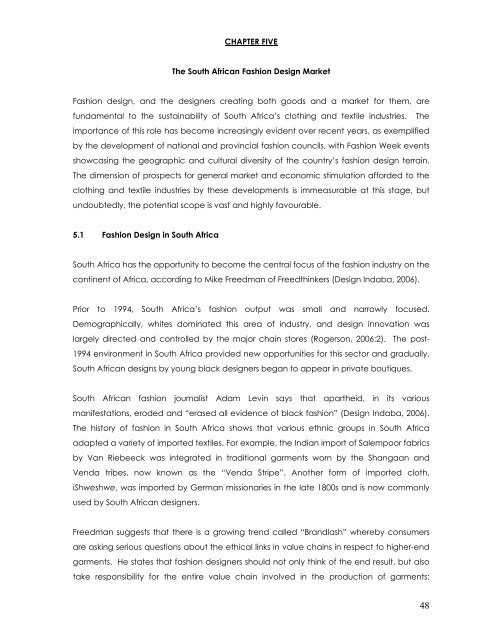You also want an ePaper? Increase the reach of your titles
YUMPU automatically turns print PDFs into web optimized ePapers that Google loves.
CHAPTER FIVE<br />
The South African Fashion Design Market<br />
Fashion design, and the designers creating both goods and a market for them, are<br />
fundamental to the sustainability of South Africa’s clothing and textile industries. The<br />
importance of this role has become increasingly evident over recent years, as exemplified<br />
by the development of national and provincial fashion councils, with Fashion Week events<br />
showcasing the geographic and cultural diversity of the country’s fashion design terrain.<br />
The dimension of prospects for general market and economic stimulation afforded to the<br />
clothing and textile industries by these developments is immeasurable at this stage, but<br />
undoubtedly, the potential scope is vast and highly favourable.<br />
5.1 Fashion Design in South Africa<br />
South Africa has the opportunity to become the central focus of the fashion industry on the<br />
continent of Africa, according to Mike Freedman of Freedthinkers (Design Indaba, 2006).<br />
Prior to 1994, South Africa’s fashion output was small and narrowly focused.<br />
Demographically, whites dominated this area of industry, and design innovation was<br />
largely directed and controlled by the major chain stores (Rogerson, 2006:2). The post-<br />
1994 environment in South Africa provided new opportunities for this sector and gradually,<br />
South African designs by young black designers began to appear in private boutiques.<br />
South African fashion journalist Adam Levin says that apartheid, in its various<br />
manifestations, eroded and “erased all evidence of black fashion” (Design Indaba, 2006).<br />
The history of fashion in South Africa shows that various ethnic groups in South Africa<br />
adapted a variety of imported textiles. For example, the Indian import of Salempoor fabrics<br />
by Van Riebeeck was integrated in traditional garments worn by the Shangaan and<br />
Venda tribes, now known as the “Venda Stripe”. Another form of imported cloth,<br />
iShweshwe, was imported by German missionaries in the late 1800s and is now commonly<br />
used by South African designers.<br />
Freedman suggests that there is a growing trend called “Brandlash” whereby consumers<br />
are asking serious questions about the ethical links in value chains in respect to higher-end<br />
garments. He states that fashion designers should not only think of the end result, but also<br />
take responsibility for the entire value chain involved in the production of garments:<br />
48
















